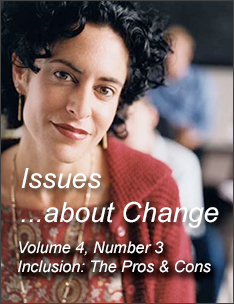Underlying Assumptions Surrounding Greater Versus Lesser Inclusion
Perhaps the strongest argument for greater inclusion, even full inclusion, comes from its philosophical/moral/ethical base. This country was founded upon the ideals of freedom and equality of opportunity. Though they have not been fully achieved, movement toward their fuller realization continues. Integration activists point to these ideals as valid for those with disabilities, too. Even opponents agree that the philosophical and moral/ethical underpinnings for full inclusion are powerful. For instance, Lieberman (1992) points out that
Jay Heubert (1994) suggests that there are several points on which proponents and opponents of inclusion agree. There is general consensus that, with appropriate staff development and support, more students with mild disabilities could be served in regular classrooms. It is also generally believed that better research, improved coordination of services between special and regular education, and administrative support are crucial for serving students with disabilities.
Heubert (1994) also outlines some of the major philosophical assumptions that proponents and opponents hold relative to their attitudes about inclusion. Those who favor greater inclusion view labeling and segregation of students with disabilities as bad. They do not view those with disabilities as distinctly different from others, but rather limited in certain abilities (everyone simply has strengths and weaknesses that vary from person to person). According to these inclusion proponents, segregated special education services are too expensive, disjoint, and inefficient. They believe that many who have been identified as being disabled are actually not disabled at all. They also believe that those students who are disabled can be best served in mainstream classes because:
- teachers who have only low-ability students have lower expectations;
- segregated programs tend to have "watered-down" programs;
- students in segregated programs tend not to have individualized programs;
- students in segregated programs tend to stay in segregated programs;
- most regular education teachers are willing and able to teach students with disabilities; and
- the law supports inclusive practices.
In contrast, those who prefer to maintain special education students in resource rooms, special classrooms, or other, more restrictive settings believe that labeling students is not bad if the labels are accurate and lead to providing appropriate services. They believe that students with disabilities are distinctly different from their non-disabled peers and, therefore, need different, specialized services. They fear that the reason many are "pushing" inclusion is to save money (special education services are costly). Inclusion opponents believe that special education identification services are sophisticated and generally reliable. According to Huebert (1994), they also believe many or most students with disabilities are better served outside the mainstream classroom setting because:
- special education teachers have higher expectations for their students;
- special education curricula are appropriate for their intended students;
- individualization is more likely to occur in smaller classes with specialized teachers than in the regular classroom;
- regular teachers do not want special needs students in their classrooms; and
- students with disabilities have never been well-served in regular education, and there is nothing to indicate that teachers are any more able to deal with them now than they were previously.
Next Page: Educational Support for Inclusion

